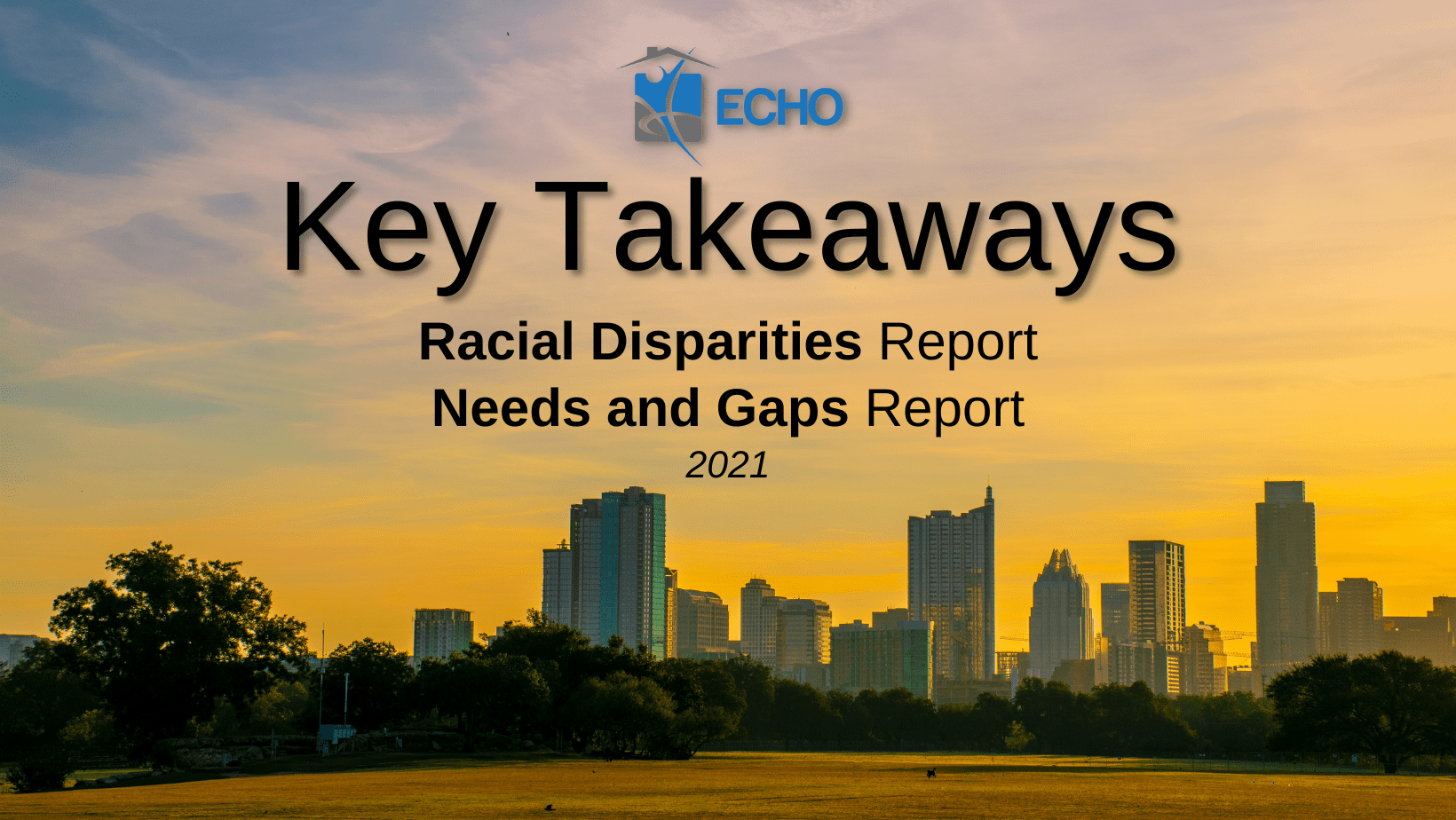New reports highlight racial inequities and the need for more housing
AUSTIN (Sept. 15, 2021) — A Black Austinite is six times more likely than a white Austinite to experience homelessness, new research from the Ending Community Homelessness Coalition (ECHO) finds.
That statistic is one of the key takeaways from the 2021 Racial Disparities Report, one of two reports published by ECHO’s Research and Evaluation Team in recent days. The other, the 2021 Needs and Gaps Report, examines who is using the local Homelessness Response System and what our community needs to make homelessness rare, brief, and non-recurring.
Both reports highlight that, while our community is taking steps to address racial inequity and a huge shortage of housing units, much work still lies ahead.
“Homelessness is not an individual issue, it’s a systemic and institutional issue. We will never be able to end homelessness in our community without addressing the racial disparities present in intersecting systems in this city. From education to employment, we know that there are inequitable outcomes that are disproportionately affecting Black, Indigenous and people of color in our community. For us to correct decades of disinvestment in homelessness response, we must be courageous in also correcting centuries of institutional and systemic racism. Undoing racism and ending homelessness are inextricably linked,” says Brion Oaks, Chief Equity Officer for the City of Austin and Chair of the Homelessness Response System Leadership Council, the governing body of the local Continuum of Care. “These reports are one more reminder that it takes sustained laser focus by our entire community to right these historical wrongs.”
Key Findings
2021 Racial Disparities Report
Many of the disparities highlighted in the report can be traced not only to racism in the community’s past response to homelessness, but also to long-standing racial barriers in housing, education, policing, criminal justice, employment, and healthcare.
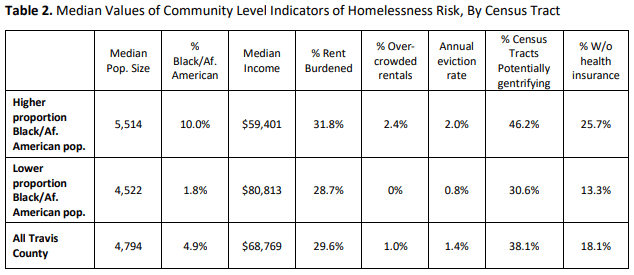
The report highlights several community-level factors that research shows contribute to risk of homelessness. These factors indicate disparities engendered by a white supremacist culture outside the Homelessness Response System that have led to the reality that a Black person living in Austin is six times more likely to experience homelessness than a white person.
At the same time, the report highlights challenges within the Homelessness Response System that lead to worse outcomes for Black and Brown people. The data show Black people are more likely to return to homelessness after being connected to housing and that Black and Hispanic/Latinx people who return to homelessness do so more quickly than white people.
Black people and white people make up roughly equal proportions of the total number of people who exited a program to permanent housing in 2019 (44% Black and 45% white). About 9% of people who were exited to housing during that year returned to homelessness within the next 12 months; Black people represented 58% of those returns. The median number of days between housing and a return for white people who returned to homelessness within a year was 172; for Hispanic/Latinx people, the median was 165 days, and for Black people, the median was just 138 days.
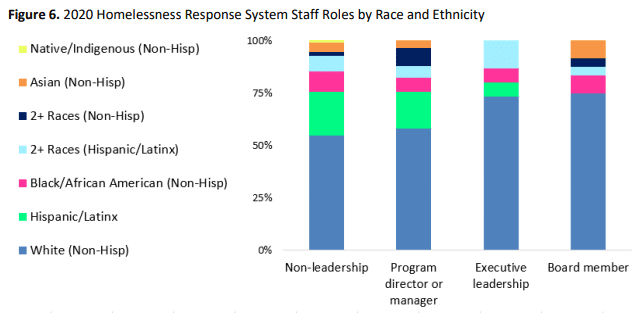
More research is needed to understand why returns (as well as inflow into first-time homelessness) is racially and ethnically disproportionate. However, in addition to community-level factors that contribute to first-time and recurring homelessness, another insight from the report provides another contributing factor: Our Homelessness Response System does not reflect the population we serve. Organizations that serve people experiencing homelessness (including ECHO) are predominantly white and non-Hispanic/Latinx, and the more senior the position in these organizations, the more likely it is to be held by a white person. These statistics are based on a convenience sample of voluntary staff surveys, so the Research and Evaluation Team notes we can’t know whether the respondents make up a representative sample of all Homelessness Response System staff. However, the findings from these surveys mirrors those described in a landmark national 2018 study from the SPARC team at national consulting firm C4 Innovations.
A system is bound to fail in providing needed services and supports to marginalized groups when members of those groups are underrepresented at every level of employment within the system. The Homelessness Response System must continue to focus on diversifying agency staffs and bringing new organizations into the system that already serve marginalized populations.
2021 Needs and Gaps Report
Emergency shelters in 2020 served less than half the households they served in 2019, the Needs and Gaps Report shows. Shelters significantly reduced capacity to allow for social distancing and stop the spread of COVID-19, and some unhoused people avoided these types of congregate spaces in favor of self-isolation. Households served by emergency shelters in 2020 fell by nearly 56% compared to 2019 due to these institutional and personal precautions.
At the same time, emergency shelters reported a sharp increase in the proportion of people connected to permanent housing. Last year, shelter providers connected 30% of people exiting their programs to permanent housing, compared to 18.6% in 2019. Although more complete data collection likely contributed to this increase, shelter providers also shifted to a housing-focused service delivery model between 2019 and 2020, meaning people are now required to work with case managers to pursue permanent housing. While this model decreases overall capacity, it likely also contributed to the near-doubling rate of exits to permanent housing.
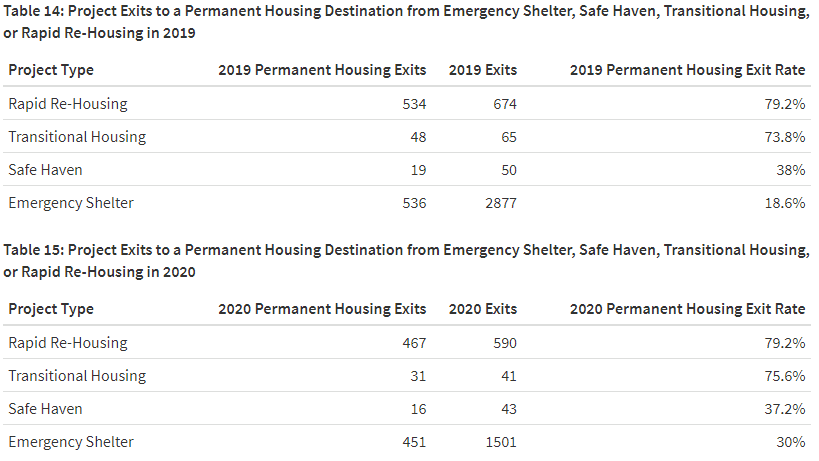
The data also make clear that the most effective interventions to ensure people remain stable are permanent housing programs. The system’s two main permanent housing programs, Permanent Supportive Housing (PSH) and Rapid Re-Housing (RRH), have a combined rate of returns to homelessness within two years of 12.9% in 2019 and 2020, a 1.7-point improvement from 2018 and 2019 numbers. This means nearly 9 in 10 people who entered a permanent housing program in 2017 and 2018 remained stably housed two years later.
At least 7 in 10 people enrolled in homelessness services programs report some kind of disabling condition. PSH programs—long-term, intensive interventions—record the highest rate of disabling conditions at 87%, with shorter-term RRH programs recording 70% disabling conditions among program participants and non-permanent housing programs recoding a disability rate of 71%.
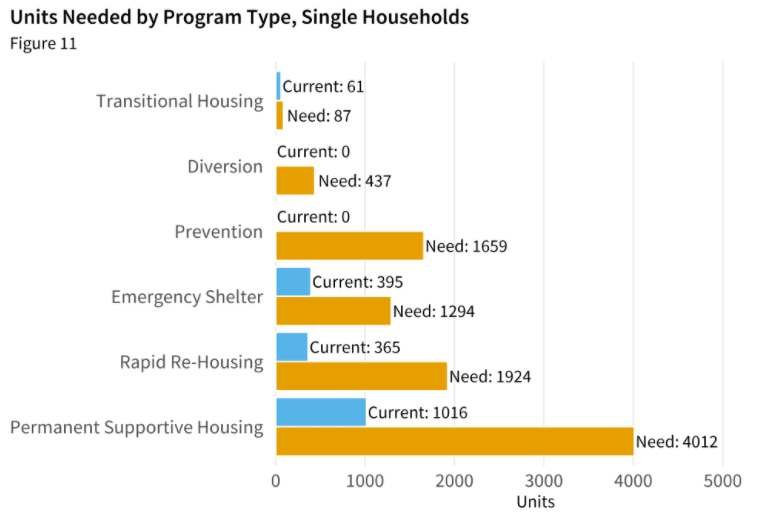
A final takeaway from the Needs and Gaps report is one that persists through every facet of the work to end homelessness in Austin/Travis County: Our community desperately needs more housing.
Programs that focus on specific subpopulations like youth and veterans are important pieces of our system, but these groups are disproportionately represented in the overall populations served by permanent housing programs. Veterans make up 58% of PSH participants (8% of non-permanent housing program participants), and youth comprise 26% of RRH participants (1% of non-permanent housing participants). These figures tell us, more than anything else, that our community needs to drastically scale up housing resources to meet the needs of everyone, not just specific subpopulations.
Modeling completed by ECHO staff and national consultants last year found our system is short nearly 6,000 units of PSH and RRH to meet the current need. That’s in addition to nearly 1,300 needed emergency shelter beds, almost 1,700 prevention units, more than 400 diversion units, and nearly 90 transitional housing units.
“Everyone deserves access to a safe, stable place to live,” says ECHO Executive Director Matt Mollica. “We can end homelessness as a community if we recognize this fundamental truth and honor it with real financial commitments from both public and private sources. It took years of our country prioritizing profits over public health to get to this point, and it’s going to take a complete re-prioritization of our resources to create a community that leads with equity and access for all.”


